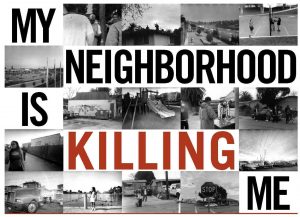Environmental Racism in the U.S
Environmental racism refers to the practices and policies that cause disadvantages (whether intentionally or unintentionally) among individuals, groups, or communities based on race, ethnicity, and color (Bullard 91). Historically, communities of color and lower income communities have received less environmental protection compared to their white, affluent counterparts. For example, according to Quan Yuan, the distribution of warehousing facilities in Los Angeles, California are disproportionately located in low income, minority communities, and this has brought about environmental concerns due to the increase of freight vehicles polluting the environment. Additionally, these warehouses affect the livability of these communities and how residents interact with their surrounding environment, as many of these warehouses store toxic and hazardous chemicals (289). These chemicals can pollute the air or seep into the ground and cause health issues among the residents living near these facilities. Lower income, minority communities are at a greater risk of developing health issues, such as cancer, due to disproportionate exposure to these toxic chemicals (Pastor 21).

Source: Image by Wake Forest University with caption “The Fight for Environmental Justice is a Fight for your life.”
Three main causes of environmental injustices are economic, sociopolitical, and racial factors (Yuan 291). As a result, many economic and political policies have been used to justify the establishment of waste and other storage facilities in these communities, as they do not have the political power to protest the establishment of these facilities in their neighborhoods, or have financial resources to move out of these communities. For example, the policy of Not in My Backyard (NIMBY) has been used against communities of color, as white communities have used this to ensure that hazardous waste facilities will not be located in their affluent neighborhoods (Bullard 90). However, new policies, such as Not in Anyone’s Backyard (NIABY) were established to ensure that everyone lives in an environmentally safe community, even people of color and those in lower socioeconomic groups.
Two case studies will be examined, the Campo Kumeyaay Landfill, located in San Diego, California, and the Old Smokey trash incinerator, located in Miami, Florida, as examples of environmental racism, as well as the counter-movement of environmental justice. Additionally, these case studies exhibit slow violence, which is defined by injustice over time as multiple generations deal with the impacts of these environmental issues, as solutions have yet to be met and implemented (Skotnicki 300). For example, many of these families have lived in these affected communities for years, as they do not have the financial resources to move or the political power to bring about any real change. Their children, grandchildren and generations to come will suffer these same environmental injustices, as they are trapped in this cycle of slow violence. The onset of the Environmental Justice movement, however, has given those affected by environmental racism and other injustices the opportunity to raise their voices and work towards change, and to ensure that everyone of all colors, races, ethnicities, and socioeconomic backgrounds have clean, safe living conditions.
Video published by The Atlantic on June 6, 2017.
Works Cited:
Bullard, Robert D. “Confronting Environmental Racism in the Twenty-First Century.” The Colors of Nature: Culture, Identity, and the Natural World, by Alison Hawthorne Deming and Lauret E. Savoy, Milkweed Editions, 2011, pp. 90–97. (Course material).
Pastor, Manuel. et al. “Environment, Disaster, and Race After Katrina.” Race, poverty & the Environment. Vol.13. no. 1. Summer 2006. p. 21-26.
Skotnicki, Tad. “Unseen Suffering: Slow Violence and the Phenomenological Structure of Social Problems.” Theory & Society, vol. 48, no. 2, Apr. 2019, pp. 299–323. EBSCOhost, doi:10.1007/s11186-019-09343-7.
Yuan, Quan. “Environmental Justice in Warehousing Location:State of the Art.” Journal of Planning Literature, vol. 33, no. 3, August 2018, pp. 287–298. EBSCOhost, doi:10.1177/0885412217753841.
Case Studies: